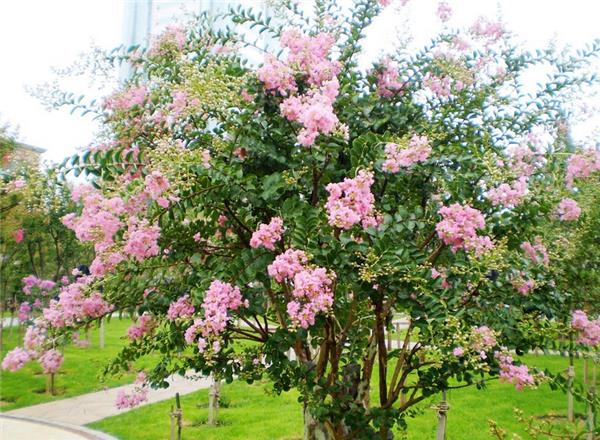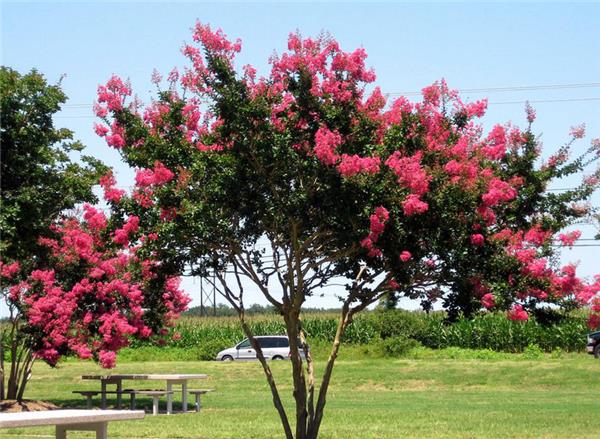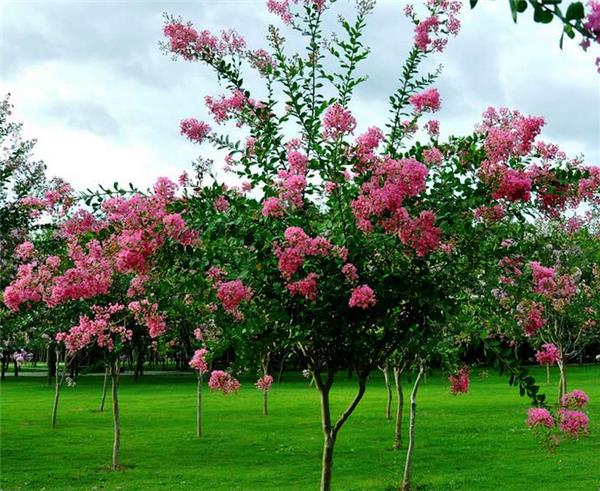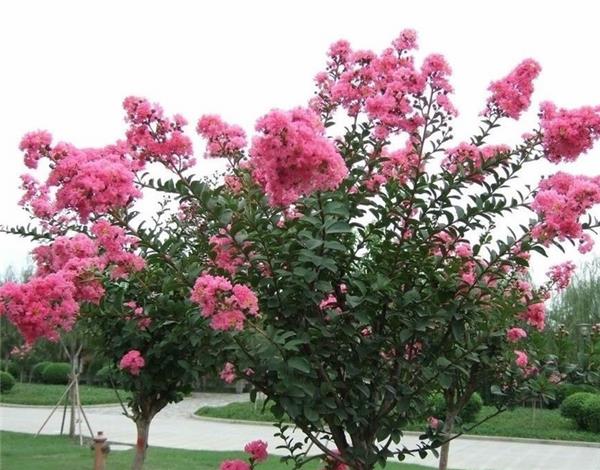Culture methods of crape myrtle
Crape myrtle tree, also known as "itchy tree", only gently touches it, it will tremble, and sometimes it will make a "giggle" sound, this strange feature is amazing, today we want to introduce to you the cultivation method of crape myrtle tree.

Culture methods of crape myrtle
Crape myrtle is generally adaptable to environmental conditions. Resistant to drought and cold. It is not strict with the soil, but it grows sturdily in fertile, deep, loose slightly acidic and acidic soil, has a long flowering period, is afraid of waterlogging, and avoids planting in low and humid places where the groundwater level is high. It likes light, needs plenty of sunlight for growth and flowering, and is slightly shady. Grow exuberantly in warm and humid climate.
Crape myrtle is usually planted from November to March of the following year. Pot planting with the seedlings of the old branches is a good way to cultivate bonsai quickly. As the crape myrtle branches are soft, potted crape myrtle can be properly clambered. Generally speaking, the growth of spring shoots stops and the branches tend to be semi-lignified, and the bonsai is made into bonsai with fine brown rope traction.

The fertilization of crape myrtle is generally more extensive. Shoot fertilizer should be applied in early March, nitrogen, phosphorus and potassium should be combined: phosphorus and potassium fertilizer should be applied once from late May to early June to strengthen branches and promote flowers, and flowering fertilizer should be applied in late July and early September respectively, and the fertilizer should be cake fertilizer and water to make the flowers bloom brightly. When the disease was found, Bordeaux solution or 600 times carbendazim solution was used to control the disease.
Crape myrtle tree grows on the top of the spring shoot that germinated that year, with strong germination and irregular crown, so it needs to be pruned. After flowering in summer, part of the residual flowers should be cut off to prevent them from bearing seeds, so as to reduce nutrient loss and promote the germination of new branches and flowering. Pruning during the growing period should not prune or cut the new branches germinated in spring, otherwise it is easy to cause only long branches without flowering, the above are the technical data of cultivation and management. In order to ensure normal flowering and the formation of large inflorescences, winter pruning is very important. Those planted in the ground should cut off the current year's branches at the fixed trunk height of the main branches, so that the strong branches will blossom in the next year, and the potted ones should first cut off all the sprouting, diseased and overlapping branches. In order to beautify the shape, it is only about 5 meters above the plump terminal bud of other branches.

Next, let's take a look at the shaping and pruning technology of crape myrtle tree.
I. Tree selection
Crape myrtle tree shape is generally divided into natural happy shape with trunk and shrub shape. Crape myrtle should make full use of the original tree shape to form a crown as soon as possible.
2. Shaping and pruning techniques
1. Fixed dry shaping: crape myrtle seedlings were cultivated for 1-2 years. When the basal diameter reached 1-2cm thick, it dried in winter.
① natural happy plastic surgery: there is a natural happy shape, generally leave a trunk, cut off at 80-100cm, thin and weak seedlings can be slightly lower, strong seedlings can be slightly higher, the branches under the cutting mouth should be removed to facilitate the concentration of nutrients. After sprouting in spring, 3-4 strong buds were selected and cultured under the shearing mouth, and the first branch under the clipping mouth was used as the trunk to extend the branch. the main branch should be at a suitable angle to the trunk, evenly distributed and with a certain distance between top and bottom. Remove all kinds of sprouts and rootstocks at any time during the growing period. In the following year, pruning during the dormant period, shortening the trunk and extending the branch 1 to 3, and cutting the first layer of main branch to 20-30cm is suitable to form a basic skeleton. Remove the auxiliary branches that affect the growth of the main branches, such as long branches and overlapping branches, etc.
② shrub shaping: the shrub shape is fixed in winter, 3-5 branches with reasonable distribution are selected as the trunk, and the trunk is cut at 50-60cm off the ground to promote branching. In spring, 3-4 branches of each trunk are retained as the first layer of lateral branches, and the middle and short branches are trimmed in the dormant period to form a basic skeleton.

two。 Cultivation and seedling pruning: after crape myrtle is dried and dormant every year, withered branches, diseased branches, juxtaposed and endophytic branches are cut short, and the main branches are extended and left side buds are trimmed lightly, generally crossing buds for about two years, so that the main branches can develop in twists and turns. The lateral branches on the main branches should be selected to grow moderately and in a suitable direction, so that the distribution of the main branches and all levels of main and lateral branches is reasonable, the upper and lower layers are scattered, elegant and orderly, and the lateral branches are generally trimmed and dried to leave outer buds in order to expand the crown. After sprouting in spring, pay attention to wipe off the dense or upright shoots in time. Natural happy shape, can gradually improve the branch height, cultivate high dry crape myrtle. Reduce flowering and fruiting as much as possible, which is beneficial to nutrient accumulation. Generally, the basal sprouting should be cut off in time, and the purple twigs can stick to each other, which is often used in nursery cultivation to wrap the basal sprouting branches around the trunk, and then heal with the trunk a few years later to achieve the effect of rapid thickening, and even make some shapes such as vases and screens.
3. Crape myrtle rejuvenation and high-end pruning, many nurseries use old crape myrtle to cultivate large-scale greening seedlings. Due to the large crown of old crape myrtle and the influence of digging, bandaging and transportation, the root is damaged greatly, and the upper branch is pruned more seriously. The backbone branches are often pruned at the branches of the 3-6-year-old branch group, and some of them are even re-pruned to the trunk. The hidden buds on the branches of crape myrtle have many hidden buds and have a long life. Through the stimulation of heavy cutting, the latent buds can produce new shoots. For the plants with less root damage and more sprouts, some overdense sprouts or new branches can be properly removed. The strong overgrown branches were selected as the main branches, and when the vigorous growing branches and long branches reached 40cm, the coring was carried out to promote the secondary branches and expand the crown as soon as possible. If the growth is not strong, the hidden buds sprouting branches under the cutting mouth should be retained as far as possible in that year, so as to promote the recovery of the tree potential, so as to achieve the cultivation purpose of rejuvenation and renewal. Many wild crape myrtle are often not ornamental and need to be improved by grafting. First, strong sprouts are selected in the suitable parts and raised as rootstocks, and the excellent varieties are grafted to form a tree crown as soon as possible before sprouting in spring. Crape myrtle with high grafting can form a larger crown for greening after 2-3 years of culture. however, attention should be paid to cutting off the sprouts on the rootstock at any time.
Generally, the basal sprouting should be cut off in time, and the purple twigs can stick to each other, which is often used in nursery cultivation to wrap the basal sprouting branches around the trunk, and then heal with the trunk a few years later to achieve the effect of rapid thickening, and even make some shapes such as vases and screens.
3. Crape myrtle rejuvenation and high-end pruning, many nurseries use old crape myrtle to cultivate large-scale greening seedlings. Due to the large crown of old crape myrtle and the influence of digging, bandaging and transportation, the root is damaged greatly, and the upper branch is pruned more seriously. The backbone branches are often pruned at the branches of the 3-6-year-old branch group, and some of them are even re-pruned to the trunk. The hidden buds on the branches of crape myrtle have many hidden buds and have a long life. Through the stimulation of heavy cutting, the latent buds can produce new shoots. For the plants with less root damage and more sprouts, some overdense sprouts or new branches can be properly removed. The strong overgrown branches were selected as the main branches, and when the vigorous growing branches and long branches reached 40cm, the coring was carried out to promote the secondary branches and expand the crown as soon as possible. If the growth is not strong, the hidden buds sprouting branches under the cutting mouth should be retained as far as possible in that year, so as to promote the recovery of the tree potential, so as to achieve the cultivation purpose of rejuvenation and renewal. Many wild crape myrtle are often not ornamental and need to be improved by grafting. First, strong sprouts are selected in the suitable parts and raised as rootstocks, and the excellent varieties are grafted to form a tree crown as soon as possible before sprouting in spring. Crape myrtle with high grafting can form a larger crown for greening after 2-3 years of culture. however, attention should be paid to cutting off the sprouts on the rootstock at any time.
Related
- Wuhan Hospital Iron Tree Blooming Result Was Instantly Frightened by the Gardener Master
- Which variety of camellia is the most fragrant and best? Which one do you like best?
- What is the small blue coat, the breeding methods and matters needing attention of the succulent plant
- Dormancy time and maintenance management of succulent plants during dormancy
- Minas succulent how to raise, Minas succulent plant pictures
- What are the varieties of winter succulent plants
- How to raise succulent plants in twelve rolls? let's take a look at some experience of breeding twelve rolls.
- Attention should be paid to water control for succulent plants during dormant period (winter and summer)
- Watering experience of twelve rolls of succulent plants
- Techniques for fertilizing succulent plants. An article will let you know how to fertilize succulent plants.



